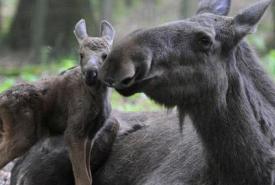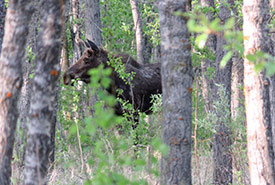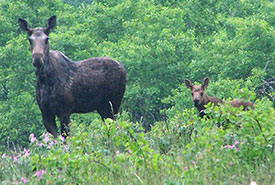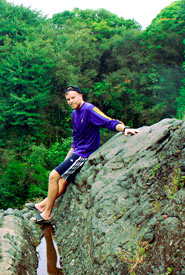A chance meeting with an iconic Canadian mammal

Moose and her calf (Photo courtesy of Wild for Wildlife and Nature)
Moose are an iconic part of Canada's wildlife. Growing up to six and a half feet tall at their shoulders and weighing up to 1,400 pounds, they are the largest species of deer in the world and one of the largest land mammals in Canada.
Crossing paths with one of these creatures is a humbling and utterly spellbinding experience. If you've come across a moose before, chances are you remember the moment vividly.
My first encounter came while hiking on the west side of Algonquin Provincial Park, when two friends and I rounded a corner to find a mother standing with her calf in the centre of the trail we were on.
Stopping dead in our tracks, we gazed in awe as the two moose stared intently back at us. As if assessing whether we were a threat or not, the mother gave us a serious look before slowly moving on. Despite the moose’s grandeur, we weren’t scared, as we could tell the mother meant us no harm — she just wanted to continue her walk through the woods with her calf.

Moose (Photo by Carissa Wasyliw)
In reality, the moose had nothing to be afraid of, as we had no weapons and, if it came down to it, we had a very low chance of winning in a toe-to-toe (or hoof) battle.
If you ever find yourself in a similar situation, by remaining calm you can see just how peaceful and wonderful these creatures really are. Though not to be taken lightly, moose know how to throw their weight around and can be very dangerous if provoked or cornered.
Moose love feeding on aquatic plants and tend to roam relatively close to lakes and creeks. If you want to spot one within the forest, stay quiet and keep a sharp lookout because, at a distance, moose can really blend in with trees and other shrubbery!
Unfortunately, there’s a ubiquitous threat for many wildlife species: climate change. Some animals are able to adapt, while others, such as moose, are not as equipped to face the effects of a warming climate.

Cow and calf moose (Photo by NCC)
Moose are very well adapted to the cold, which is why they thrive in Canada, but with warmer summers and shorter winters they’ve become vulnerable to overheating, disease and winter ticks.
I, for one, will never forget my experience with a moose and her young calf out for a stroll. It’s sad to think that future generations of hikers, campers, kids, adults or any other nature lover may not get to enjoy this same experience.
It’s everyone’s right to enjoy Canada’s beautiful backyard, but due to climate change and habitat fragmentation this may be taken away for many people. That’s why the conservation of Canada’s vast and diverse landscapes is pivotal to the success of species such as moose.
I know I am not alone in hoping that things get better for our beloved Canadian wildlife; there’s really no substitute for spotting a moose or other animal in the wild.


